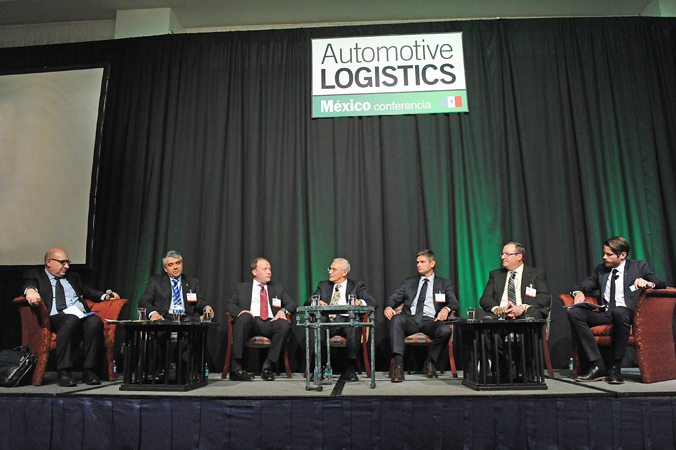 The second Automotive Logistics Mexico conference, held in Mexico City, saw hundreds of executives and officials discuss how best to ensure that the country’s fast-growing automotive production and supply chain will be fit for purpose by 2020 and beyond. Christopher Ludwig reports on plenty of progress, as well as reasons to worry. Rachael Hogg contributed to this report
The second Automotive Logistics Mexico conference, held in Mexico City, saw hundreds of executives and officials discuss how best to ensure that the country’s fast-growing automotive production and supply chain will be fit for purpose by 2020 and beyond. Christopher Ludwig reports on plenty of progress, as well as reasons to worry. Rachael Hogg contributed to this report
In a global economic outlook that has darkened amidst falling oil prices and stock indices, slowing global trade and increasingly unstable emerging markets, Mexico has remained a beacon of light, particularly for automotive investment. Supported by a favourable business and investment climate, competitive wages and close proximity and trade ties to the US, carmakers and tier suppliers continue to increase production in the country. After light vehicle production reached a record 3.4m units in 2015, and with several new plants and investments underway, reaching or surpassing 5m units per year by the end of the decade seems to many players in the sector to be almost a foregone conclusion.
However, if 5m has become an industry mantra, so too have the many concerns that surround the country’s infrastructure for ports, rail, and the US-Mexico border, as well as cargo theft and security concerns, all of which officials and executives at the Automotive Logistics Mexico conference once again expressed.
In this report...
“We have a 21st century industry operating with infrastructure from the past century,” said Ildefonso Guajardo Villarreal, Mexico’s secretary of the economy in the administration of the president, Enrique Peña Nieto. “The industry cannot continue enduring a lack of specialised automotive terminals. We need to work together to remove the obstacles preventing us from building new ports and expanding the ones we already have.”
There was a sense that solutions would have to be found quickly as the growth in output continues. The drop in the price of oil by 40% over the past year, and nearly 80% over the past two years, has hurt the Mexican federal budget, which draws significant revenue from oil sales.
There are already examples where money is running short. A hugely important rail project in Celaya, in central Mexico, that would allow Mexico’s two class I railways, Ferromex and Kansas City Southern de Mexico (KCSM), to bypass the city, is now years overdue and effectively out of funding. Until the project is complete, trains will continue to have to slow considerably in the area, which leads to more theft and vandalism on board.
*Check back as more stories, video interviews and material from the conference is published
Videos
- -View video recordings of most sessions
- -Interview: Karl-Friedrich Koch, vice-president, production control, logistics for BMW
- -Interview: Chris Styles, senior director of logistics, Nissan North America
- -Interview: Peter Koltai, director of production control and logistics, Audi Mexico
- -Interview: Volker Vossler, vice-president of operations for Mexico, Seglo-Schnellecke
- -Interview: Steve Tripp, vice-president, global strategy and execution, ICL Systems
Stories
- -Logistics is key to Mexico's growth
- -Reaching the 'exponential phase'
- -BMW's global plans for San Luis Potosi
- -Audi adapts logistics for San José Chiapa
- -Freeing trade from all points
- -Swapping customs agents, cross-border trucking and other happenings at the border
- -Rail and truck capacity challenges
If the reality in Mexico is to match its forecasts – as it mostly has over the past several years of strong production and export growth – then the worry over missing or inadequate facilities certainly has merit. Both AMIA and PwC’s Autofacts, an analyst group, forecasted that light vehicle production would exceed 5m by 2020. Brandon Mason, lead analyst for the Americas at Autofacts, said that Mexican light vehicle assembly would reach 5.3m units by 2020.
According to Mason, of that nearly 2m unit rise, about 900,000 units are expected to come from the country’s existing 15 assembly plants, while 964,000 units would come from new plants already announced by Audi, Hyundai-Kia, Toyota, BMW and a joint venture between Daimler and Nissan to build Infiniti and Mercedes-Benz vehicles.
As more than 80% of Mexican production is exported – a ratio that is expected to be maintained – vehicle shipments abroad are expected to rise in line with production, from about 2.8m units in 2015 to more than 4.2m by the end of the decade. Automotive parts exports are also growing – Mexico is the largest parts suppliers to the US, while shipments beyond North America are also on the rise.

Brandon Mason also pointed out that the domestic Mexican vehicle market, though small in comparison to the rest of North America, has shown signs of dynamism, including for new vehicle imports. After the Mexican government made efforts to reduce the import of older used cars from the US, the local market has grown by more than 70% since 2010, reaching a record 1.35m units in 2015. Vehicle imports have risen sharply, particularly from overseas, with non-NAFTA imports rising by 33% in 2015 compared to 2014 to nearly 565,000 units – led by the Volkswagen Group at nearly 170,000 units, including a large amount of vehicles imported from India.
This volume, however, has put even more pressure on vehicle handling and capacity at Mexican ports, notably Veracruz on the east coast, the country’s largest.
The exponential phase
While Mexico continues to struggle with growing pains in parts of its supply chain, the conference was also a testament to the progress, acceleration and development of the country’s economic stability and its current logistics operations. For Mexico, success is not just being measured in pure volume terms, although these are already impressive, as it ranks as the seventh largest vehicle producer globally, and 4th largest exporter. Also notable, however, is the move towards higher value vehicles, technology and services.
 Ildefonso Guajardo, the secretary of the economy, said the private sector should fill the gap in federal funding on infrastructure
Ildefonso Guajardo, the secretary of the economy, said the private sector should fill the gap in federal funding on infrastructure“Today, we are on the verge of what I call the ‘exponential phase’ [in Mexico’s automotive development], in which Mexican production of vehicles is growing in both volume and quality, by advancing in technological sophistication to get into the production of premium vehicles,” said Ildefonso Guajardo, the secretary of the economy. (Read more here)
Guajardo pointed to the current production of Cadillac SRX by General Motors, and the Lincoln MKZ by Ford, which will soon be followed later this year by the Audi Q5 at a new plant in San José Chiapa, in the state of Puebla. Over the next three years, Nissan’s Infiniti brands, Mercedes-Benz and BMW will all launch production in Mexico.
“The production of premium cars embodies innovation, safety and design, all of which demand a highly skilled workforce and advanced quality processes, which are now the main components of the competitiveness of the Mexican automotive industry,” said Guajardo.
AMIA’s Eduardo Solis also maintained that Mexico had become much more than a low-cost manufacturing base for carmakers; gone are the days when assemblers mainly installed parts built in the US, or when the bulk of the supplier sector in Mexico were maquiladoras processing material from the US duty-free for re-export. According to AMIA figures, Mexican-based manufacturers and tier suppliers are adding an average of 55.4% of domestic value. “We are not outsourcing, we are talking strong plants with an extremely high added value,” he said.
 AMIA’s Eduardo Solis said that Mexican automotive production added, on average, 55 per cent of local added value
AMIA’s Eduardo Solis said that Mexican automotive production added, on average, 55 per cent of local added value“If carmakers were only after cheap labour costs, they would be building assembly plants in Guatemala, Honduras or other Central American countries that have lower labour costs than Mexico, and not a single assembly plant,” he said.
Guajardo pointed to the amount of research and development centres being added to Mexico, as well as in the growth of tier suppliers, of which there are now around 850 automotive parts companies in the country. “[Suppliers in Mexico] strengthen the industry and provide it with a product diversification that benefits assemblers and has given our country an export capacity of around $50 billion,” said Guajardo.
Free trade dealings
Mexico’s development as a high-value manufacturing and export centre is supported by a number of economic and regulatory factors. While GDP growth has been fairly sluggish for an emerging market, estimated at around 2.5% in 2015, Mason at PwC predicted it would rise to 3.5% by 2018. Inflation has also been relatively low.
Manufacturers investing in Mexico have also sought to combine this stability with the advantages of the country’s wide array of free trade agreements (FTAs). Mexico currently has about 12 FTAs involving 44 countries, including the US and Canada in NAFTA, as well as deals with the European Union and Latin American countries. Guajardo, who plays a major role in facilitating such deals, is in the process of negotiating or updating agreements with the EU and the European Free Trade Area, Turkey, Jordan and Brazil, among others.
Perhaps most critically, last year Mexico joined the US, Canada, Japan and eight other countries in Latin America and Asia on the Pacific Rim in agreeing the Trans-Pacific Partnership (TPP). If ratified by national governments, it would be Mexico’s most important deal since NAFTA; member countries represent about 40% of global GDP, and it would open up trade considerably with Asia.
Indeed, Mexico already has a global export profile, but currently more than 80% of its vehicle exports go to the US and Canada, said Eduardo Solis, a number that has increased following continued economic problems in other Latin American countries, like Brazil. However, premium brands entering the country have revealed plans for a more diverse range of locations. Audi will take advantage of Mexico’s FTAs by making San José Chiapa the mother plant for the Audi Q5 crossover. According to director of production control and logistics for Audi Mexico, Peter Koltai, the carmaker expects to export 47% of vehicles from the plant to Europe, 38% to North America, 8% to Asia, with the rest going to South America, Australia and Africa.
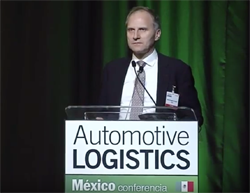 Karl-Friedrich Koch said that BMW's upcoming plant in Mexico will ship around one-third of its vehicles beyond North America
Karl-Friedrich Koch said that BMW's upcoming plant in Mexico will ship around one-third of its vehicles beyond North AmericaKarl-Friedrich Koch, vice-president of production control and logistics for BMW’s planned plant in San Luis Potosi, which will open in 2019, revealed that while BMW expects two-thirds of its production to remain in North America (including 61% to the US), more than a third would move beyond the continent, including 21% to Europe.
Will logistics support or hinder the next phase?
Despite worries over bottlenecks, Mexico’s logistics network has supported automotive growth so far. The country has a reasonably well-developed infrastructure, including 117 deep-sea and coastal ports, although automotive material and vehicles move mostly through a handful, including Veracruz, Altamira, Lázaro Cárdenas and Manzanillo.
Mexico also has nearly 27,000km of railways, and carmakers benefit in particular from Mexico’s integration with other North American railways and a shared pool of rail wagons. A large proportion of automotive material – perhaps 30-40% – moves to and from factories in Mexico to regions of the US and Canada by rail and intermodal transport.
For outbound logistics, the proportion is even higher. According to Carlos Velez, vice-president of business solutions and marketing for Kansas City Southern, 85% of vehicles exported from Mexico to the US and Canada move by rail. He suggested that the railways could manage to carry a similar proportion or higher of vehicle exports as they grow over the coming years without an unmanageable investment. A large share of vehicles exported to major ports like Veracruz and Lázaro Cárdenas also move from plants to the docks by rail.
This use of rail is particularly notable compared to other emerging markets. Brazil, for example, moves very little automotive material or vehicles, while the penetration rate in markets like India and elsewhere in Asia is also very low.
While there are delays and constraints at the US-Mexico border, in many ways the crossings and customs function well considering the huge volumes flowing back and forth. Ryder’s Daniel Hearn, director of international customer logistics, revealed that truckload border crossings to the south had grown by 26% between 2009 and 2014, and said that the Laredo crossing – which is the most used for automotive material – is “on fire”, with nearly 3m truck and rail crossings per year. Laredo’s truckloads have increased by 41% between 2009 and 2014, representing around 36% of southbound truckloads.
However, while Mexico has coped so far, worries remain that current facilities and processes will not be enough to handle the expected growth. Ildefonso Guajardo said that Mexico had no choice but to modernise its infrastructure and logistics to meet the predicted demands of the automotive industry.
“Now, the size of the Mexican automotive industry demands more, bigger and specialised ports to avoid congestion and delays in export terminals,” said Guajardo. He pointed in particular to the lack of specialised automotive terminals as a critical issue for the world’s fourth largest exporter of vehicles.
Though volume makes its way across the border, Ryder’s Darcee Scavone, vice-president and general manager for automotive, aerospace and industrial supply chain operations, said that freight is still held up for hours. Although the US has made some move to allow Mexican trucks and drivers to operate over the border, in practice very few Mexican companies can afford the insurance costs, and both American and Mexican companies face an array of challenges in operating on the opposite side of the border. Therefore, almost all freight still needs to be switched between truck and rail teams and equipment.
 Ryder's Darcee Scavone pointed to drayage operations and illegal activity at the border as among the challenges OEMs and 3PLs must face
Ryder's Darcee Scavone pointed to drayage operations and illegal activity at the border as among the challenges OEMs and 3PLs must faceMike Casidy, managing director for Mexico at Penske Logistics, pointed to a shortage of equipment in Mexico, in part because carriers in Mexico typically own their equipment rather than lease it, as would be more common in the US. “If you ask a [Mexican] company to buy 50 more trucks in a year, that represents a big investment for them,” he said. “There needs to be incentives from governments and banks to help carriers get financing at a low interest rate, as rates are high here [compared to the US].”
Supply chain issues are not limited to physical infrastructure and equipment. Executives also highlighted the urgency in training and developing engineers and workers both to serve Mexico’s growing production as well as to strengthen the local supplier and logistics provider base. Casidy said that some areas of the country in particular lack qualified drivers.
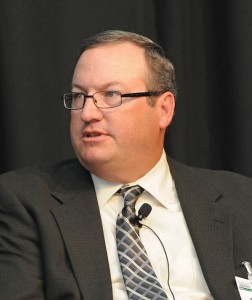 Penske's Mike Casidy called for a nationwide truck-driver qualification programme in Mexico
Penske's Mike Casidy called for a nationwide truck-driver qualification programme in Mexico“We would like to see plans for a driver training programme in Mexico, otherwise it will be a problem in the coming years,” he said.
Peter Koltai at Audi highlighted the need to train and educate workers, from engineers through to logistics experts and drivers. Koltai worried that surging production growth would outpace local skills and require companies to import more engineers from Germany or the US. “That’s very expensive,” he said.
As Mexico builds more advanced, global models, its plants are also set to require a more complex inbound supply chain, which further exposes some of the local supply and skills gaps in Mexico. “Part of what I see is the supply base has to continue growing too, including parts manufacturers and logistics service suppliers,” said Chris Styles, senior director of logistics for Nissan North America. “There has to be an ongoing capacity increase that supports us in building a vehicle.”
Koltai also spoke about the need to import a fairly high proportion of material and technology – in Audi’s case, about 35% from Europe – that could not yet be localised in Mexico. “For example, we use a lot of aluminium, including for the surface of the car, as well as for many parts,” said Koltai. “However, we don't have adequate supply in Mexico, and have to import it.”
Karl-Friedrich Koch at BMW’s planned plant in San Luis Potosi, expressed similar concerns. “We have to keep track of all tier suppliers with regard to quality and delivery assurance,” he said. “We’re not quite happy with the level of volumes that will come over from Europe, and we want to reduce that.”
 FCA's Mercedes Figueroa said that border crossings are made more efficient when companies on each side are C-TPAT and NEEC qualified
FCA's Mercedes Figueroa said that border crossings are made more efficient when companies on each side are C-TPAT and NEEC qualifiedShe also highlighted actions that are being taken by the Mexican federal government, including an investment of 1.6 billion pesos ($88.3m) in Juarez, Tijuana and Mexicali to increase customs clearance modules and operational capacity. There are also plans to use more gamma ray equipment and eliminate additional customs checkpoints.
Figueroa highlighted port development projects as well, including investments planned or underway for Veracruz and Altamira both for port facilities and rail connections.
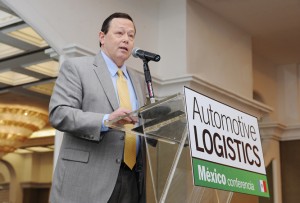 William Duncan, the chargé d’affaires for the US Embassy to Mexico, was hopeful that bi-national custom agent trials would lead to efficiencies at the border
William Duncan, the chargé d’affaires for the US Embassy to Mexico, was hopeful that bi-national custom agent trials would lead to efficiencies at the borderWilliam Duncan, the chargé d’affaires for the US Embassy to Mexico (a role that serves effectively as ambassador), also revealed important steps being taken on both sides of the border to improve operations. As of just the last few months, several trials for cargo pre-inspection have begun on the US side in Laredo, Texas, as well as on the Mexico side in Tijuana. In both cases, American customs officials are working on the Mexican side of the border, and Mexicans on the US side.
“This may not seem like a big deal, but it is a significant step forward, and could pave the wave towards more seamless border crossing,” said Duncan. “To make it happen, Mexico even had to change a federal law to allow US customs officers to carry their firearms in Mexico. Those were the kind of things that held us up in the past, but which we are now able to work through.” (Read more here)
North American networks
Carmakers and their logistics providers are increasingly using more complex systems of monitoring and tracking to manage their border crossings and integrate logistics networks across the entire region. While this is an approach that has been somewhat more common across GM, Ford and FCA, which have long-standing operations on both sides of the border and manage the networks centrally from Detroit, it is becoming increasingly common for transplants to North America to operate this way as well.
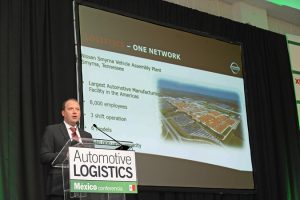 Chris Styles revealed that Nissan has now combined all its North American plants into a combined logistics network, with Penske as an LLP
Chris Styles revealed that Nissan has now combined all its North American plants into a combined logistics network, with Penske as an LLPChris Styles revealed that Nissan – the biggest carmaker in Mexico in production and sales – contracted Penske Logistics last September to work as a lead logistics provider (LLP) across all of its US and Mexican plants as “one network”. The Nissan network, which includes car and engine plants in Tennessee and Mississippi, as well as in Mexico in Aguascalientes and Cuernavaca, represents more than 5,200 conveyances per week, 1,045 suppliers and 27 carriers.
These flows also include a growing amount of freight moving over the border, including 313 truckloads per week moving northbound over the road, with 170 truckloads moving south to Mexico; for rail flows, Nissan and Penske move 161 truckloads northbound, and 103 southbound.
Tim Flucht, strategic account executive for Penske Logistics, said that border crossings had tended to be something of a “black hole” when it first evaluated the Nissan network, but that the provider had since installed a network milestone track-and-trace system that monitored all touch-point timings, including through the complex and timely drayage process at the border.
“The system has brought much more visibility and transparency to the process, and allows us to intervene early where we see there might be a problem,” said Flucht.
Styles called the contracting of an LLP "an enhancement" of Nissan's previous logistics management. "It gave us some of the tools that we were missing to manage the border and our overall network more effectively," he said.
 Peter Koltai at Audi Mexico said that the new plant would be integrated with other Volkswagen plants in the region for logistics
Peter Koltai at Audi Mexico said that the new plant would be integrated with other Volkswagen plants in the region for logisticsPeter Koltai, meanwhile, revealed that Audi has, together with other Volkswagen Group plants in North America, combined planning for freight flows across plants and suppliers in the region into a single network, including Volkswagen’s assembly plant in Chattanooga, Tennessee, its large assembly plant in Puebla and its engine plant in Silao.
“This allows for more synergies across our supply base and in our logistics,” Koltai said.
The fact that North American logistics networks are increasingly engineered as one is also partly reflected in the growing use of returnable containers both within Mexico and in exchanges across the border. Sharon Gray, global director of automotive key accounts at packaging-solutions provider Chep, says that companies in Mexico are very open to working with the company for packaging. “Because things are very new and growing fast, people are interested and we’re getting a great reaction to returnable services,” she said.
Robert Strain, head of global automotive for Goodpack, agreed that Mexico was an important market for packaging services, although he saw more room for considering the use of returnable packaging. “Packaging should be considered more in the total cost of ownership for parts, rather than simply looking at the piece price,” he said.
Competing with the world
Far from being an underdeveloped market for logistics services and concepts, manufacturers in Mexico boast highly reliable and developed services. “Our logistics performance in Mexico is excellent, and of the same standard as in the US. We don’t shut plants down,” said Nissan’s Styles.
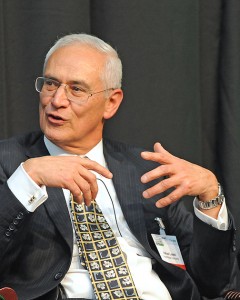 Ford's Rafael Lopez said that Mexican carmakers need to use technology and automation to stay ahead of competitors
Ford's Rafael Lopez said that Mexican carmakers need to use technology and automation to stay ahead of competitorsRafael López, director of material planning and logistics for Ford Mexico, also pointed to the continuing development of production, supply chain and technology in Mexico. He predicted, for example, that OEMs would continue to invest strongly in automation and other productive processes to keep their operations as competitive as possible.
“We will continue to advance productivity, taking advantage of robotics and new digital tools where appropriate that envision the entire [order-to-delivery] process, including suppliers, manufacturing, distribution and logistics,” he said.
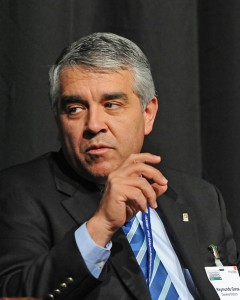 GM's Raymond Garza said that Mexico had to stay ahead of competing nations in Asia as much as the Americas
GM's Raymond Garza said that Mexico had to stay ahead of competing nations in Asia as much as the AmericasOther executives also pointed to the importance for Mexico’s logistics and supply chain to remain as competitive as possible in cost and performance, particularly as it competes not only with other plants in North America but, especially after TPP, with plants in Asia.
“For Mexico, one of the points is not only growth, but we need to prepare, need resources to ensure we grow competitively,” said Raymundo Garza, director of global purchasing and supply chain at General Motors. “It’s a big challenge, but that is the only way we will keep growing.
“We have to look at everything we do, including operational costs, everything labour, fuel, etc.; we need to make sure we optimise everything,” continued Garza. “Because we are not just competing with the US and Canada, we are competing with the guys in Asia.”
Automotive Logistics Mexico is part of the global Automotive Logistics series of conferences.
The next conference in the series is Automotive Logistics Europe, in Bonn, Germany March 15-17th.
The next conference to be held in North America will be the first Automotive Logistics – The Supply Chain Conference, in Atlanta, Georgia May 17-19th
Topics
- Africa
- africa
- asia
- Asia
- Asia Pacific
- Asia Pacific
- Central America
- Central America
- CHEP
- crossborder
- europe
- Europe
- features
- Finished vehicles
- GM
- Government and policy
- Inbound
- Integrated LSPs
- Interviews
- Middle East
- middle east
- Nissan
- North America
- north america
- OEMs
- Policy and regulation
- Rail
- Rail
- Ryder
- South America
- South America
- south america
- Tier suppliers
- Track-and-trace
- Trucking







































